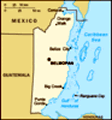Advertisement
Published: January 26th 2008

 Cahal Pech
Cahal Pech
We're about to enter the Cahal Pech museum before continuing on to the ruins. Cahal Pech is one of the oldest Mayan sites. Andrew and I spent yesterday afternoon and evening relaxing. We climbed up the bird watching tower and spotted many birds, although the only one we recognized was the bird of paradise. No toucans! About twenty feet or so away from the tower, the people who work at the resort hang a basket of fruit in a high tree that they change out every few days or so. When we were up in the tower, the basket was occupied by a single, large iguana. The reptile must have hit the jackpot finding that pile of fruit! We figured he climbed the tree to get into it, but we couldn't figure out how he'd get out, so after sitting there for a bit, we let Kim (one of the owners at the resort) know. She told us that, yes, they have to lower the basket to get the iguana out, and she also told us that he constantly climbs the tree to get to the fruit, usually after it ferments in the sun, and he gets a bit drunk eating it all. So, yes, we saw a drunk iguana while watching for birds.
Today, Victor took Andrew and me, along

 A Mayan Ruler
A Mayan Ruler
Here are the remains of a Mayan ruler.with another couple staying at the resort, to Cahal Pech to see Mayan ruins. Cahal Pech is one of the oldest Mayan sites, with some things dating to 2000 B.C., I believe. The oldest ruins are actually below ground, because the Mayan people would build on top of their old buildings. This means the oldest ruins we actually saw dated from about the time of Jesus (Do you call that 0AD? I don't think so). We saw many old buildings and temples from about 500 A.D. or so, of the late classic period. Victor explained to us that only the royal family would stay in the elaborate stone structures. The rest of the village would stay in huts around the large wall surrounding the center. At its peak, there were about a million people in Belize during that time. Now, there are about 300,000. Incredible!
Andrew and I got to actually climb up the stone steps to the temple and explore the hallways and bedrooms. All of the paint has worn away from the stone (except on one of the benches in one of the bedrooms), and most of the plaster is also gone. When it was new,
apparently, everything was painted brightly, and all the trees were cleared from the area so you could see it from miles away. It's spectacular.
In addition to the hallways and bedrooms and temple, Victor walked us by one of the ballcourts (the other has not been excavated yet, and there are currently no plans to begin doing so). The ballcourts are where teams would play a game, perhaps similar to volleyball, only with a 9 pound rubber ball containing a human skull inside. Many of the games would end in a sacrifice and decapitation of one of the team's captains. It's not clear if it would be the losing team or winning team that would be chosen as the sacrifice.
Cahal Pech contained the largest piece of jade ever unearthed at a Mayan site. It was a mask, and it used to be held at the museum at Cahal Pech, although it's recently been moved to a museum in Belize City. Andrew and I won't be able to see it, unfortunately. We learned that jade, not gold, was most precious to the Mayan people. They didn't use gold at all until much later.
At

 Chocolate Pot
Chocolate Pot
For hot chocolate, of course! I'm very thankful for the Mayans and their invention of the hot chocolate.the museum (which was part of the site), we got to see a cocoa pot; apparently, the Mayans drank hot chocolate, which they spiced. Yum! We also saw the remains of a Mayan ruler. Apparently, when a family member of the ruling family died, they were buried within the stone bench-like beds in the bedrooms. It was believed that, if they were buried inside, it was easy to contact the ancestor during times of need. Other bodies were buried in tombs also at Cahal Pech, but this area had not been excavated yet.
I need to quickly finish the blog, as we're about to leave to go kayaking. However, I'd like to add that we were taught about more plants in the area, including the give-and-take tree and the allspice tree. We also were shown a plant that provided glue for the Mayans. It was super interesting. However, I need to head out to the pier to head off on our kayaking trip. I'll try to post as soon as I'm back!
Advertisement
Tot: 0.064s; Tpl: 0.022s; cc: 14; qc: 25; dbt: 0.0316s; 1; m:domysql w:travelblog (10.17.0.13); sld: 1;
; mem: 1.1mb

























